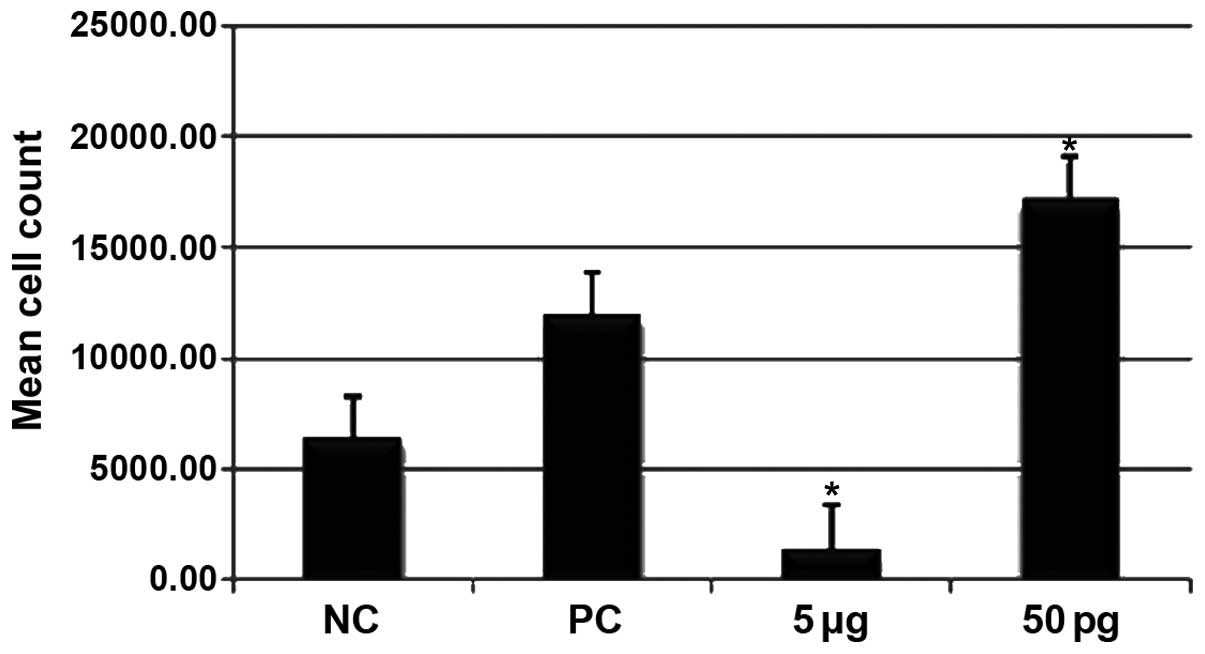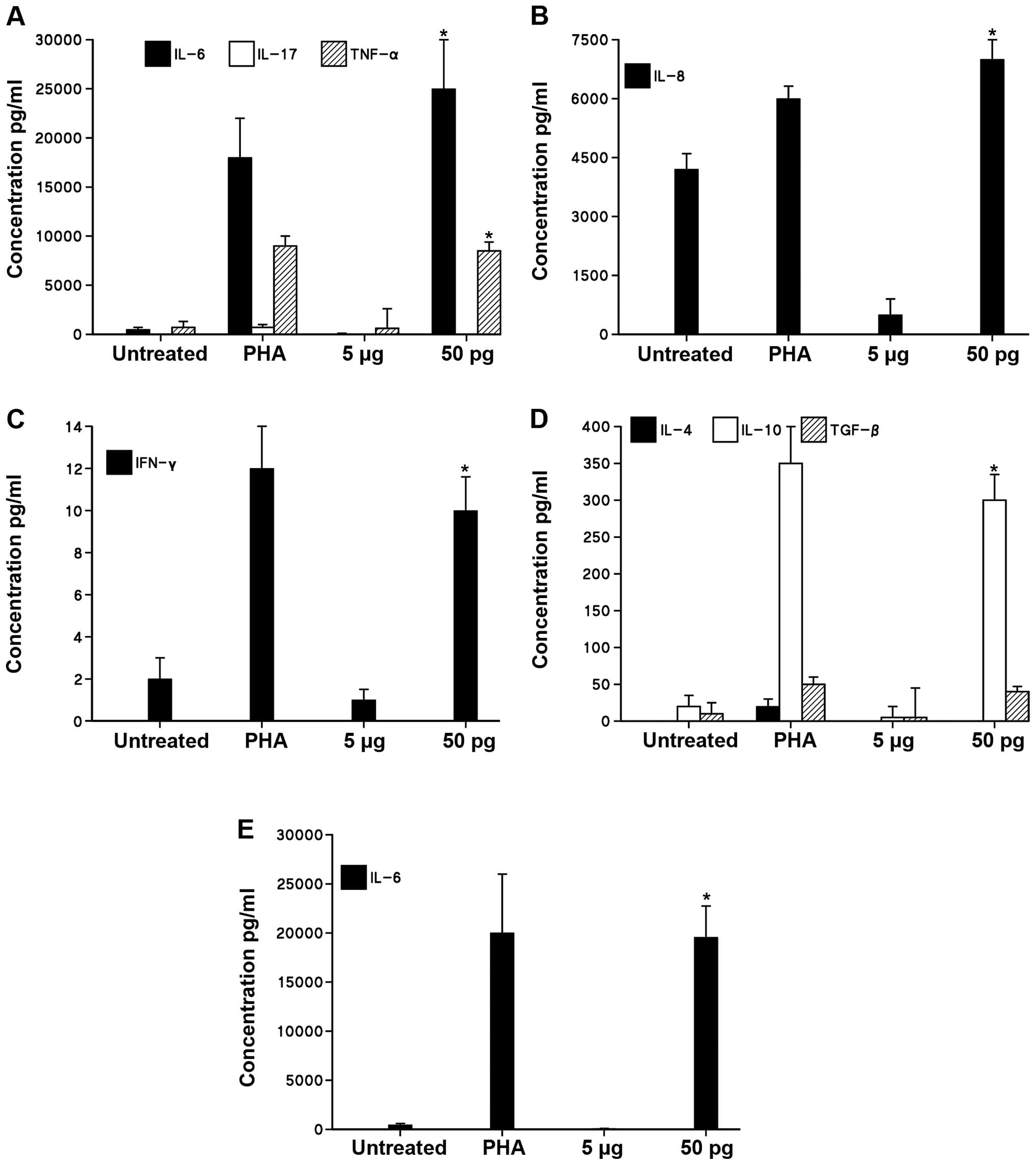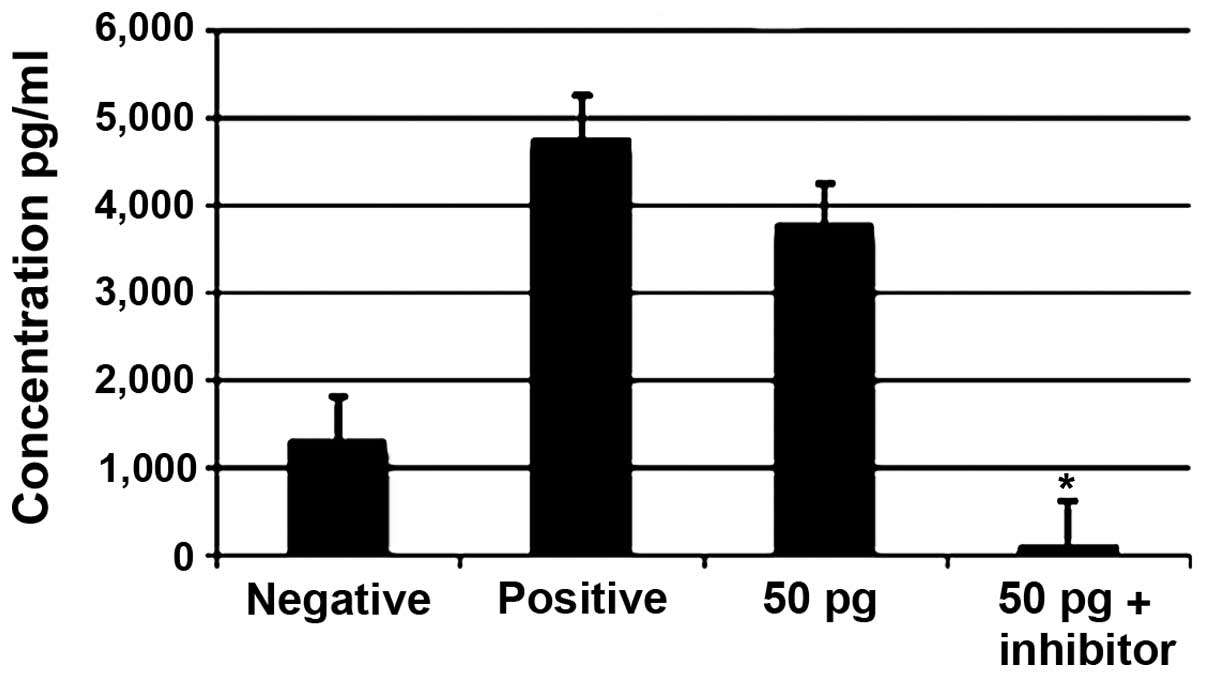|
1
|
Bakhiet M and Taha S: A novel nervous
system-induced factor inducing immune responses in the spleen.
Immunol Cell Biol. 86:688–699. 2008. View Article : Google Scholar : PubMed/NCBI
|
|
2
|
Taha S, Fathallah MD and Bakhiet M: An
interspecies conserved motif of the mouse immune system-released
activating agent (ISRAA) induces proliferative effects on human
cells. Mol Med Rep. 10:75–81. 2014.PubMed/NCBI
|
|
3
|
Arch RH, Gedrich RW and Thompson CB: Tumor
necrosis factor receptor-associated factors (TRAFs) - a family of
adapter proteins that regulates life and death. Genes Dev.
12:2821–2830. 1998. View Article : Google Scholar : PubMed/NCBI
|
|
4
|
Chang F, Steelman LS, Shelton JG, Lee JT,
Navolanic PM, Blalock WL, Franklin R and McCubrey JA: Regulation of
cell cycle progression and apoptosis by the Ras/Raf/MEK/ERK pathway
(Review). Int J Oncol. 22:469–480. 2003.PubMed/NCBI
|
|
5
|
Elmore S: Apoptosis: a review of
programmed cell death. Toxicol Pathol. 35:495–516. 2007. View Article : Google Scholar : PubMed/NCBI
|
|
6
|
Ibelgaufts H: Cytokines. Cytokines &
Cells Online Pathfinder Encyclopedia. Version 31.4. Spring/Summer.
2013 edition.
|
|
7
|
Pollard TD, Earnshaw WC,
Lippincott-Schwartz J and Johnson GT: Cell biology. 2nd edition.
Saunders/Elsevier; Philadelphia: 2008
|
|
8
|
Ubersax JA and Ferrell JE Jr: Mechanisms
of specificity in protein phosphorylation. Nat Rev Mol Cell Biol.
8:530–541. 2007. View
Article : Google Scholar : PubMed/NCBI
|
|
9
|
Sallusto F and Lanzavecchia A: Efficient
presentation of soluble antigen by cultured human dendritic cells
is maintained by granulocyte/macrophage colony-stimulating factor
plus interleukin 4 and downregulated by tumor necrosis factor
alpha. J Exp Med. 179:1109–1118. 1994. View Article : Google Scholar : PubMed/NCBI
|
|
10
|
Cairo MS, Wagner EL, Fraser J, Cohen G,
van de Ven C, Carter SL, Kernan NA and Kurtzberg J:
Characterization of banked umbilical cord blood hematopoietic
progenitor cells and lymphocyte subsets and correlation with
ethnicity, birth weight, sex, and type of delivery: A Cord Blood
Transplantation (COBLT) Study report. Transfusion. 45:856–866.
2005. View Article : Google Scholar : PubMed/NCBI
|
|
11
|
Morgan E, Varro R, Sepulveda H, et al:
Cytometric bead array: A multiplexed assay platform with
applications in various areas of biology. Clin Immunol.
110:252–266. 2004. View Article : Google Scholar : PubMed/NCBI
|
|
12
|
Bradford MM: A rapid and sensitive method
for the quantitation of microgram quantities of protein utilizing
the principle of protein-dye binding. Anal Biochem. 72:248–254.
1976. View Article : Google Scholar : PubMed/NCBI
|
|
13
|
Leonard M, Ryan MP, Watson AJ, Schramek H
and Healy E: Role of MAP kinase pathways in mediating IL-6
production in human primary mesangial and proximal tubular cells.
Kidney Int. 56:1366–1377. 1999. View Article : Google Scholar : PubMed/NCBI
|
|
14
|
Jones SA, Horiuchi S, Topley N, Yamamoto N
and Fuller GM: The soluble interleukin 6 receptor: Mechanisms of
production and implications in disease. FASEB J. 15:43–58. 2001.
View Article : Google Scholar : PubMed/NCBI
|
|
15
|
Rao MS, Sun Y, Escary JL, Perreau J,
Tresser S, Patterson PH, Zigmond RE, Brulet P and Landis SC:
Leukemia inhibitory factor mediates an injury response but not a
target-directed developmental transmitter switch in sympathetic
neurons. Neuron. 11:1175–1185. 1993. View Article : Google Scholar : PubMed/NCBI
|
|
16
|
Yamamori T, Fukada K, Aebersold R,
Korsching S, Fann MJ and Patterson PH: The cholinergic neuronal
differentiation factor from heart cells is identical to leukemia
inhibitory factor. Science. 246:1412–1416. 1989. View Article : Google Scholar : PubMed/NCBI
|
|
17
|
Lo DC: A central role for ciliary
neurotrophic factor? Proc Natl Acad Sci USA. 90:2557–2558. 1993.
View Article : Google Scholar : PubMed/NCBI
|
|
18
|
Heinrich PC, Behrmann I, Haan S, Hermanns
HM, Müller-Newen G and Schaper F: Principles of interleukin
(IL)-6-type cytokine signalling and its regulation. Biochem J.
374:1–20. 2003. View Article : Google Scholar : PubMed/NCBI
|
|
19
|
Galabova-Kovacs G, Kolbus A, Matzen D,
Meissl K, Piazzolla D, Rubiolo C, Steinitz K and Baccarini M: ERK
and beyond: insights from B-Raf and Raf-1 conditional knockouts.
Cell Cycle. 5:1514–1518. 2006. View Article : Google Scholar : PubMed/NCBI
|
|
20
|
Kolch W: Meaningful relationships: the
regulation of the Ras/Raf/MEK/ERK pathway by protein interactions.
Biochem J. 351(Pt 2): 289–305. 2000. View Article : Google Scholar : PubMed/NCBI
|
|
21
|
Pagès G, Guérin S, Grall D, Bonino F,
Smith A, Anjuere F, Auberger P and Pouysségur J: Defective
thymocyte maturation in p44 MAP kinase (Erk 1) knockout mice.
Science. 286:1374–1377. 1999. View Article : Google Scholar : PubMed/NCBI
|
|
22
|
Pawson T: Regulation and targets of
receptor tyrosine kinases. Eur J Cancer. 38(Suppl 5): S3–S10. 2002.
View Article : Google Scholar
|
|
23
|
Rouse J, Cohen P, Trigon S, Morange M,
Alonso-Llamazares A, Zamanillo D, Hunt T and Nebreda AR: A novel
kinase cascade triggered by stress and heat shock that stimulates
MAPKAP kinase-2 and phosphorylation of the small heat shock
proteins. Cell. 78:1027–1037. 1994. View Article : Google Scholar : PubMed/NCBI
|
|
24
|
Galabova-Kovacs G, Catalanotti F, Matzen
D, Reyes GX, Zezula J, Herbst R, Silva A, Walter I and Baccarini M:
Essential role of B-Raf in oligodendrocyte maturation and
myelination during postnatal central nervous system development. J
Cell Biol. 180:947–955. 2008. View Article : Google Scholar : PubMed/NCBI
|
|
25
|
Shaul YD and Seger R: The MEK/ERK cascade:
From signaling specificity to diverse functions. Biochim Biophys
Acta. 1773:1213–1226. 2007. View Article : Google Scholar
|
|
26
|
Yoon S and Seger R: The extracellular
signal-regulated kinase: Multiple substrates regulate diverse
cellular functions. Growth Factors. 24:21–44. 2006. View Article : Google Scholar : PubMed/NCBI
|
|
27
|
Kyriakis JM and Avruch J: Mammalian
mitogen-activated protein kinase signal transduction pathways
activated by stress and inflammation. Physiol Rev. 81:807–869.
2001.PubMed/NCBI
|
|
28
|
Roux PP and Blenis J: ERK and p38
MAPK-activated protein kinases: A family of protein kinases with
diverse biological functions. Microbiol Mol Biol Rev. 68:320–344.
2004. View Article : Google Scholar : PubMed/NCBI
|
|
29
|
Brunet A, Roux D, Lenormand P, Dowd S,
Keyse S and Pouysségur J: Nuclear translocation of p42/p44
mitogen-activated protein kinase is required for growth
factor-induced gene expression and cell cycle entry. EMBO J.
18:664–674. 1999. View Article : Google Scholar : PubMed/NCBI
|
|
30
|
Lenormand P, Sardet C, Pagès G, L'Allemain
G, Brunet A and Pouysségur J: Growth factors induce nuclear
translocation of MAP kinases (p42mapk and p44mapk) but not of their
activator MAP kinase kinase (p45mapkk) in fibroblasts. J Cell Biol.
122:1079–1088. 1993. View Article : Google Scholar : PubMed/NCBI
|
|
31
|
Heinrich PC, Behrmann I, Müller-Newen G,
Schaper F and Graeve L: Interleukin-6-type cytokine signalling
through the gp130/Jak/STAT pathway. Biochem J. 334:297–314. 1998.
View Article : Google Scholar : PubMed/NCBI
|
|
32
|
Mertens C, Zhong M, Krishnaraj R, Zou W,
Chen X and Darnell JE Jr: Dephosphorylation of phosphotyrosine on
STAT1 dimers requires extensive spatial reorientation of the
monomers facilitated by the N-terminal domain. Genes Dev.
20:3372–3381. 2006. View Article : Google Scholar : PubMed/NCBI
|
|
33
|
Xu X, Sun YL and Hoey T: Cooperative DNA
binding and sequence-selective recognition conferred by the STAT
amino-terminal domain. Science. 273:794–797. 1996. View Article : Google Scholar : PubMed/NCBI
|
|
34
|
Bhat NR and Zhang P: Hydrogen peroxide
activation of multiple mitogen-activated protein kinases in an
oligodendrocyte cell line: Role of extracellular signal-regulated
kinase in hydrogen peroxide-induced cell death. J Neurochem.
72:112–119. 1999. View Article : Google Scholar : PubMed/NCBI
|
|
35
|
Ishikawa Y and Kitamura M: Anti-apoptotic
effect of quercetin: Intervention in the JNK- and ERK-mediated
apoptotic pathways. Kidney Int. 58:1078–1087. 2000. View Article : Google Scholar : PubMed/NCBI
|
|
36
|
Kim YK, Kim HJ, Kwon CH, Kim JH, Woo JS,
Jung JS and Kim JM: Role of ERK activation in cisplatin-induced
apoptosis in OK renal epithelial cells. J Appl Toxicol. 25:374–382.
2005. View Article : Google Scholar : PubMed/NCBI
|
|
37
|
Jo SK, Cho WY, Sung SA, Kim HK and Won NH:
MEK inhibitor, U0126, attenuates cisplatin-induced renal injury by
decreasing inflammation and apoptosis. Kidney Int. 67:458–466.
2005. View Article : Google Scholar : PubMed/NCBI
|




















